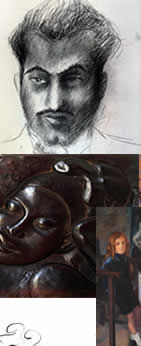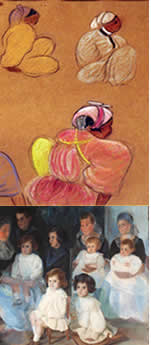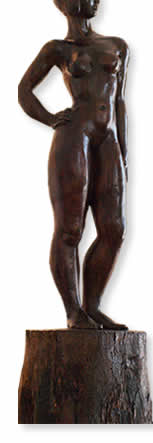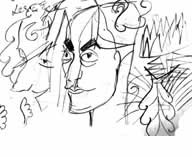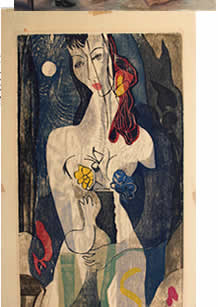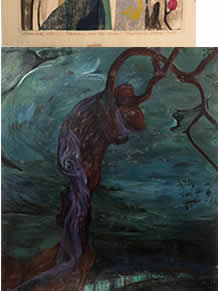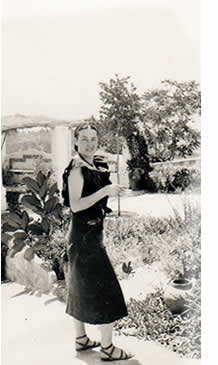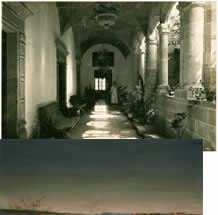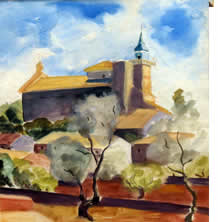Now, more than 75 years after she took her own life, the first volume of a biography of Pazzis Sureda, Spanish artist, is now available in galley. The longer, second volume in galley will be available in the summer. The final two volume set, bilingual edition, is to be officially published and available for sale in fall 2015.
Por fin, más de 75 años después de que se quitara la vida, las galeradas del primer volumen de la biografía de la artista española Pazzis Sureda ya están disponibles. Las galeradas del segundo volumen estarán disponibles en verano. El conjunto final de dos volúmenes, en edición bilingüe, se publicará oficialmente y estará a la venta en otoño de 2015.
This book is based on previously unseen original sources from the 1920s and 1930s. The newly discovered documents tell a story of passion, art, dreams, wealth, poverty, prison, war, sex crime, pornographic fantasies, jealousy, and infidelity without jealousy. The letters reveal secrets unknown for generations. The book also mines the unpublished manuscript of Irving Pflaum, journalist, to reveal previously unknown information about the Spanish Civil War.
Este libro se basa en fuentes originales inéditas de los años 1920 y 1930. Los documentos recién descubiertos cuentan una historia de pasión, arte, sueños, riqueza, pobreza, prisión, guerra, crímenes sexuales, fantasías eróticas, celos e infidelidad sin celos. Las cartas revelan secretos ocultos durante generaciones. El libro también saca a la luz el manuscrito inédito de Irving Pflaum, periodista, para revelar información hasta ahora desconocida sobre la Guerra Civil Española.
Pazzis broke every social convention: she lived with a man to whom she was not married, wore pants, and had various lovers. As original and open to the world as she was, her life, dreams and thoughts could not have happened anywhere else other than Spain in the 1930s. Her art was utterly idiosyncratic: using techniques she learned from Spanish peasants in the mountains of Aragon, she sculpted modernist representations of Africa while living with her American lover.
Pazzis rompió todas las convenciones sociales: vivió con un hombre con el que no estaba casada, vistió pantalones, y tuvo varios amantes. Original y abierta al mundo, su vida, sus sueños y pensamientos no podrían haber transcurrido en otro lugar que no fuese la España de la década de 1930. Su arte era totalmente idiosincrásico: haciendo uso de técnicas que aprendió de campesinos españoles en las montañas de Aragón, esculpió representaciones modernistas de África mientras vivía con su amante americano.
The cast of characters in Pazzis' life include Pazzis' husband, Fernando Esteban, the good-looking, witty, English-speaking playboy, politically liberal writer and cartoonist who refused to bend to to Franco's forces and still managed to survive, her lover Frederick O'Hara, a sincere, American, Bohemian painter, her lover Francisco Vizcaíno, poet and painter, her brother Jacobo Sureda, poet, painter and co-publisher of Manifesto Ultra with Jorge Luis Borges, her twin sister Susana, in an insane asylum from a young age, her brother Pedro, artist with a propensity for accidentally sparking disasters, her mother the artist Pilar Montaner, a great artist, like Pazzis, even if estranged from her daughter, Juan Sureda, her father, patron of many famous artists and staunchly orthodox in both his madness and Catholicism, Albert Vigoleis Thelen, anti-fascist German author of the classic comedic novel Island of Second Sight, 1954, largely about his relationship with the Sureda family, George Copeland, pianist, Lorenzo Villalonga, writer of Catalan-language literature, Werner Weber, Swiss painter, a Nazi engineer, and others, Spanish, foreign, communist, neutral and pro-fascist.
El elenco de personajes en la vida de Pazzis incluye a su marido, Fernando Esteban, playboy que hablaba inglés, bien parecido, ingenioso, escritor de ideas políticas liberales y dibujante que se negó a someterse a las fuerzas de Franco y se las arregló para sobrevivir; a su amante Frederick O'Hara, americano, pintor bohemio y sincero; a su amante Francisco Vizcaíno, poeta y pintor; a su hermano Jacobo Sureda, poeta, pintor y co-autor del Manifiesto ultra junto con Jorge Luis Borges; a su hermana gemela Susana, internada en un manicomio desde una edad temprana; a su hermano Pedro, artista con propensión a los desastres accidentales; a su madre Pilar Montaner, gran artista como Pazzis, aunque a veces distante de su hija; a Juan Sureda, su padre, mecenas de muchos artistas famosos, ortodoxo incondicional tanto en su locura como en el catolicismo; a Albert Vigoleis Thelen, alemán antifascista autor de la novela clásica de comedia La isla del segundo rostro, 1954, que trata en gran parte de su relación con la familia Sureda; a George Copeland, pianista; a Lorenzo Villalonga, escritor en lengua catalana; a Werner Weber, pintor suizo; a un ingeniero nazi, y a otros, españoles, extranjeros, comunistas, neutrales y pro-fascistas
Born in a palace as one of 11 children of the richest man on Mallorca, Pazzis would come to know hunger, manual labor, violence and chronic illness. Although she wrote and made art profusely and corresponded with writers, musicians and painters all over the world, she had only three years of schooling. The misfortunes of life never stopped her from sculpting and creating impressive sculptures and other art, as did so many others in her troubled and pulsating world of the 1930s.
Nacida en un palacio, siendo una de los once hijos de uno de los hombres más ricos de Mallorca, Pazzis llegaría a conocer el hambre, el trabajo físico, la violencia y la enfermedad. A pesar de que escribió, creó arte profusamente y mantuvo correspondencia con escritores, músicos y pintores de diferentes países, sólo dispuso de tres años de escolaridad. Las desgracias de la vida nunca le impidieron esculpir y crear impresionantes obras de arte, al igual que tantos otros artistas en ese sufrido pero vibrante mundo de la década de 1930.
Her diary is full of poetry, emotion and dreams. Reading the Romantic poet Shelley in the original English and thinking of a man she knew in the Pyrenees she never kissed, Pazzis decided that sexual fidelity was not for her, as she wrote in her diary. She then took a lover. Weeks before the start of World War II, she would write scathing poetry condemning the entire human race, most especially herself. She then took her own life.
Su diario está lleno de poesía, emoción y sueños. Leyendo al poeta romántico Shelley en inglés original y evocando a un hombre que conoció en los Pirineos y a quien nunca besó, Pazzis decidió que la fidelidad sexual no era para ella, y así lo escribió en su diario. A continuación, tomó un amante. Pocas semanas antes del inicio de la Segunda Guerra Mundial, escribiría poesía mordaz condenando a toda la raza humana y, sobre todo, a sí misma. Luego se quitó la vida.
Pazzis: The Gospel of Pazzis Sureda 1907-1939 is the collaboration of Patricia Veiret, Pazzis' grand niece, who discovered more than 700 period letters in Spain, and Will Pflaum, the American grandson of the novelist who fictionalized Pazzis' life. Bolero by Melanie Pflaum, 1956, tells the story of Pazzis' love for two men, both of whom considered her happiness more than their own jealousy.
Pazzis: El Evangelio de Pazzis Sureda 1907-1939 es la colaboración de Patricia Veiret, sobrina nieta de Pazzis, que descubrió más de 700 cartas de época en España, y Will Pflaum, estadounidense, nieto de la novelista que escribió una ficción sobre la vida de Pazzis. Bolero de Melanie Pflaum, 1956, narra la historia de amor entre Pazzis y dos hombres, los cuales tanto el uno como el otro ponen por encima la felicidad de Pazzis a sus propios celos.
As original as Pazzis was, so is her biography, called a gospel by the authors. Inspired by Thelen, Pazzis, Irv and the 17th century Japanese writer Basho, this book includes, in addition to hysterical and heart-breaking period letters and diary entries, prose, poetry, images, digressions, philosophy, sacrilege, religion, tragedy and more than its share of humor. Pazzis: The Gospel of Pazzis Sureda 1907-1939, asks you to rethink history, art, love, and how we live.
Tan original como ella misma es su biografía, llamada evangelio por los autores. Inspirado en Thelen, Pazzis, Irv y el escritor japonés Basho del siglo XVII, este libro incluye, además de las pasionales y desgarradoras cartas de época y apuntes de diario, prosa, poesía, imágenes, digresiones, filosofía, sacrilegio, religión, tragedia y más de un toque de humor. Pazzis: El Evangelio de Pazzis Sureda 1907-1939, es una llamada a replantearse la historia, el arte, el amor y cómo vivimos.
Pazzis: The Gospel of Pazzis Sureda 1907-1939 / El evangelio de Pazzis Sureda 1907-1939
Patricia Veiret Sautter, William Pflaum • ISBN/EAN13: 1508756392 / 9781508756392
Páginas • Pages: 492 • Español • English

